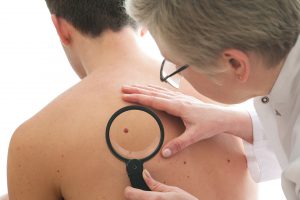Could there be danger lurking inside that mole on my skin?

Nearly all of us have some sort of mole or brown spot on our skin. In fact, the average adult has anywhere from 10 to 40.
Most of the time we don’t give much thought to our moles; we see them as simply a part of the landscape of our skin. It is, however, a good idea to keep an eye on them, as they can occasionally develop into a serious, possibly life-threatening disease.
Moles usually occur when melanocytes – the cells that give our skin pigment—form a cluster, creating a concentrated patch of color. Quite often, moles begin as small, flat spots. Over time, they become raised. They may flatten again, become paler and even disappear altogether. Most of them never become cancerous.
Some moles, however, may develop into melanoma, a form of skin cancer. Because of this possibility, you should have any unusual moles checked out by a dermatologist.
So how do you know if a mole is unusual? The American Academy of Dermatology advocates looking for the “ABCDEs of melanoma” to determine whether a mole may be dangerous:
A is for asymmetry: One half of the mole doesn’t match the other half.
B is for border: The border or edges of the mole are ragged, blurred or irregular.
C is for color: The color of the mole is not the same throughout, or it has shades of tan, brown, black, red, white or blue.
D is for diameter: The mole is larger than 6 millimeters, which is about the size of a pencil eraser.
E is for evolving: The mole changes in size, shape or color.
If a mole displays any of these signs, it should be checked promptly by a dermatologist.
Only about 10 percent of people develop unusual or atypical moles, and just one in 10,000 of these moles will turn out to be malignant (cancerous). To the untrained eye, an atypical mole can look just like a normal one, but a doctor can see the difference under a microscope.
Although skin cancer is on the rise, you should never worry about the implications of cancer before you have the mole examined and diagnosed by a qualified dermatologist.
Incidentally, medical studies have shown that irritation from shaving over a mole will not cause the mole to develop cancer. However, you might want to have a dermatologist remove such a mole to eliminate the irritation.
Anyone can develop a malignant melanoma, but some people are more at risk than others. Risk factors include:
- Being female (double the incidence compared with men).
- Having fair skin with lots of freckles.
- Sunbathing, especially in the tropics.
- Episodes of severe sunburn in the past.
- Having lots of moles on your skin.
- Other members of your family with skin cancer.
Children rarely develop many moles before puberty, so it is very unlikely they will experience problem moles.
Melanomas are rare in people with dark skin, although they do occasionally occur, including on the soles of the feet.
If a biopsy indicates the presence of cancerous cells, your doctor will probably recommend removing it, along with some surrounding margin (normal) tissue. This is to ensure that no cancerous cells remain around the site of the mole.
There are various techniques for removal, depending on where the mole is on your body. Moles on the face are treated particularly carefully to minimize scarring. Board-certified dermatologists are specially trained to achieve the most aesthetic results for the removal of moles, even very large ones on the face.
The earlier cancerous moles are diagnosed, the easier they are to treat. Malignant melanoma is very different from other skin cancers and, if untreated, can spread to other organs. This is a very dangerous disease. But if diagnosed and treated early enough, there is an excellent chance of recovery.
If you have any concerns about a mole anywhere on your body, it is important to make an appointment with a qualified dermatologist, who can accurately evaluate you and help with any treatment you may require.
*Individual results may vary; not a guarantee.
Schedule Now Patient Info Guide








